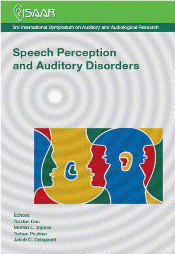The role of working memory capacity and speed of lexical access in speech recognition in noise
Abstract
Cognitive skills are important for speech processing and comprehension. The objective of the present investigation was to address the role of working memory capacity and speed of lexical access in speech processing in noise. This was done by measuring speech recognition thresholds (SRTs) in background noise with the Hagerman test and the Swedish HINT. Cognitive capacities were measured by a lexical-decision making test and a reading- span test. Forty hearing impaired individuals, aged 44-86 years, participated in the study. The relations between SRTs and cognitive scores were studied using correlation analyses and analysis of variance for high and low cognitive performance groups. The individuals showed significant correlations between SRTs and cognitive scores which remained also after correcting for PTA4. A higher demand on cognitive processing was found for the criteria of 80% compared to 50 % speech recognition.
References
Davis, M.H. and Johnsrude, I.S. (2007). “Hearing speech sounds, Top-down influences on the interface between audition and speech perception” Hear Res 229, 132-147.
Foo, C., Rudner, M.., Ronnberg, J. and Lunner, T. (2007). “Recognition of speech in noise with new hearing instrument compression release settings requires explicit cognitive storage and processing capacity” J Am Acad Audiol, 18, 618-31.
Glasberg, B. and Moore, B. C. J. (1989). “Psychoacoustic abilities of subjects with unilateral and bilateral cochlear hearing impairments and their relationship to the ability to understand speech” Scand Audiol, Suppl 32, 1-25.
Hagerman, B. (1982). “Sentences for testing speech intelligibility in noise” Scand Audiol, 11, 79-87.
Houtgast, T. and Festen, J.M. (2008). “On the auditory and cognitive functions that may explain an individual's elevation of the speech reception threshold in noise” Int J Audiol, 47, 287-95.
Humes, L. (2005). “Do 'auditory processing' tests measure auditory processing in the elderly?” Ear and Hearing, 26, 109-19.
Hällgren, M., Larsby, B. and Arlinger, S. (2006). “A Swedish version of the Hearing In Noise Test (HINT) for measurement of speech recognition” Int J Audiol, 45, 227-237.
Hällgren, M., Larsby, B., Lyxell, B. and Arlinger, S. (2001). ”Evaluation of a cognitive test battery in young and elderly normal-hearing and hearing-impaired subjects” J Am Acad Audiol, 12, 357-370.
Larsby, B., Hällgren, M., Lyxell, B. and Arlinger, S. (2005). “Cognitive performance and perceived effort in speech processing tasks: Effects of different noise backgrounds in normal-hearing and hearing-impaired subjects” Int J Audiol, 44, 131-143.
Larsby, B., Hällgren, M. and Lyxell, B. (2008). “The interference of different background noises on speech processing” Int J Audiol, 47, Suppl 2, S83-90. Lunner, T. (2003). “Cognitive function in relation to hearing aid use” Int J Audiol, 42: S49-S58.
Lunner, T. and Sundewall-Thorén, E. (2007). “Interactions between cognition, compression, and listening conditions: effects on speech-in-noise performance in a two-channel hearing aid” J Am Acad Audiol, 18, 539–552.
Lyxell, B., Andersson, U., Borg, E. and, Ohlsson, I.-S. (2003). “Working-memory capacity and phonological processing in deafened adults and individuals with severe hearing impairment” Int J Audiol, 42, Suppl 1, S86-S89.
Pichora-Fuller, M.K. (2003). “Processing speed and timing in aging adults: psychoacoustics, speech perception, and comprehension” Int J Audiol, 42, Suppl 1, S59-67.
Plomp, R. (1986). “A signal-to-noise ratio model for the speech-perception threshold of the hearing impaired” J Speech Hear Res, 29, 146-154.
Additional Files
Published
How to Cite
Issue
Section
License
Authors who publish with this journal agree to the following terms:
a. Authors retain copyright* and grant the journal right of first publication with the work simultaneously licensed under a Creative Commons Attribution License that allows others to share the work with an acknowledgement of the work's authorship and initial publication in this journal.
b. Authors are able to enter into separate, additional contractual arrangements for the non-exclusive distribution of the journal's published version of the work (e.g., post it to an institutional repository or publish it in a book), with an acknowledgement of its initial publication in this journal.
c. Authors are permitted and encouraged to post their work online (e.g., in institutional repositories or on their website) prior to and during the submission process, as it can lead to productive exchanges, as well as earlier and greater citation of published work (See The Effect of Open Access).
*From the 2017 issue onward. The Danavox Jubilee Foundation owns the copyright of all articles published in the 1969-2015 issues. However, authors are still allowed to share the work with an acknowledgement of the work's authorship and initial publication in this journal.


